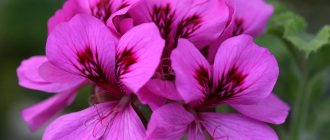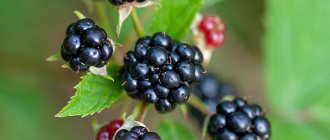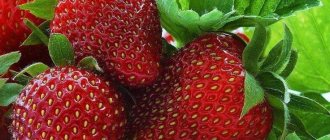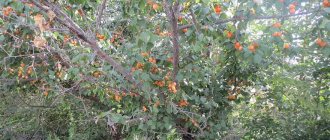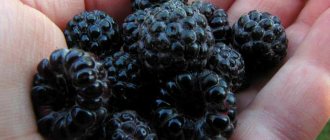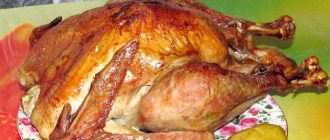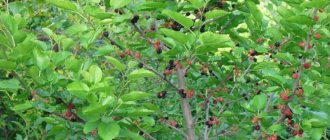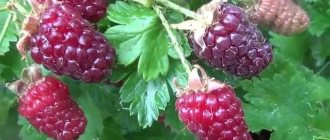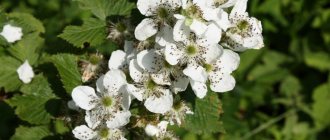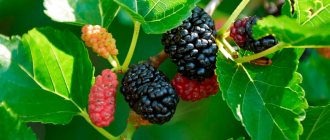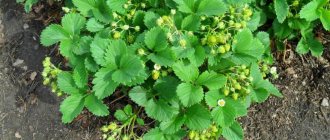What is commonly called a "berry" in blackberries is not actually a berry. This type of fruit is called a prefabricated drupe. The blackberry flower is multi-pistillate, and around each pistil a small, juicy fruit with one seed inside is formed. A lot of these fruits, collected together, are that very tasty and aromatic blackberry.
Collective drupes are formed in many plants. Some of them are blue-black and so similar to blackberries that they mislead the uninitiated. Plants whose fruits resemble blackberries are discussed in this review.
Black raspberries, similar to blackberries
This plant is still exotic in Russian gardens. In appearance, it is indeed easy to confuse it with a blackberry: a shrub with prickly shoots and leaves typical of raspberries and blackberries. When ripe, black raspberry fruits change color from pink, through dark red, to black. And they taste a little like blackberries.
And yet there is a difference: when harvested, the black raspberry drupes are easily removed from the fruit stalk - like a thimble from your finger. Regular red or yellow raspberries behave in exactly the same way. In blackberries, the harvest is harvested together with the fruit and stalk, because its drupes grow tightly together in their place.
Chokeberry cultivated raspberries originate from the American wild raspberry - blackberry-like raspberry.
At the beginning of the 19th century, N. Lonagvart began to introduce this plant into culture. In the United States, black raspberries quickly became popular. Through the efforts of breeders, its varieties Remontantnaya from Ohio, Evans, Dundee, and Bristol were developed.
In Russia today, two varieties of black raspberries are cultivated: Cumberland and Ugolyok.
Black raspberries on a bush
How they grow
The difference between mulberries and blackberries becomes obvious when you see the plants in the garden.
A normal mature mulberry tree produces a beautiful large crown, valuable wood and a variety of fruits. The young tree grows very quickly, but after a few years the growth slows down, and the trunk with smooth bark gradually thickens. The wood is beautiful, strong and heavy; it is used in arts and crafts, construction and cooperage, and in Central Asia it is used to make musical instruments.
The lush spreading crown is formed by strong, widely spaced branches, covered with simple leaves with a jagged edge. The tree blooms in the spring with small flowers, invisible among the blossoming foliage, collected in small inflorescences, which then turn into edible fruit.
In fact, what we call a berry is a conglomerate of fused very small seeds covered with a nutritious (sweet and healthy) shell. The fruits ripen from the beginning of summer. You can enjoy them for up to 5 weeks.
The difference between blackberries is immediately noticeable - it is a very picturesque thorny shrub. Flexible shoots grow or spread along the ground; at the forest edge they are so intertwined that they form impenetrable thickets. At dachas they are often planted around the perimeter, but the growth is strictly controlled. To maintain the ability to care for the plant and prevent the fruits from being crushed, the bush is heavily pruned every year. The branches are covered with sharp thorns, dark green leaves, consisting of 3 or even 5 parts.
Raspberry Cumberland
This is a very old variety of American selection. It was obtained at the end of the 19th century by D. Miller, and quickly moved to Europe. Until recently, Cumberland was the only chokeberry variety known in Russia. It has taken root in our gardens thanks to its undoubted advantage - high frost resistance (up to -30⁰C).
Cumberland forms a powerful bush with shoots up to three meters long. Shoots with a large number of thorns grow like semi-creeping blackberries: initially erect, they bend in an arc as they grow. At the same time, the tops, reaching the ground, are able to take root. Therefore, Cumberland, although it does not produce root shoots, can “walk” around the site.
The fruits of Cumberland raspberries are small and their yield is not very high. But the high density allows the crop to be stored for a long time and tolerate transportation well.
Cumberland looks especially decorative in the fall. At this time, its shoots acquire an exotic bluish-blue color. Thanks to these qualities, Cumberland can be used to form a hedge that will be both “tasty”, beautiful, and reliable.
Cumberland raspberry variety
Berry lacquer plant
An extremely rare plant in our latitudes, surprising with its exotic fruits. Segmented, juicy black fruits on long “cobs” look like blackberries.
This herbaceous plant of the Phytolacca family is native to North America. A perennial that annually produces several thick stems up to 1.5 meters high. Long erect inflorescences of Laconia plant appear at the end of May and vaguely resemble the blooming of hyacinths. Many greenish-pink flowers give the plant a very decorative appearance.
The fruits of the berry lacquer ripen towards the end of summer. By this time, the fruit becomes red, and against its background the black “blackberries” look surprisingly impressive. The juice of this plant has a rich, dense scarlet color.
As Paracelsus said, “everything is poison, and everything is medicine.” Lakonos, indeed, is recognized as a poisonous plant. Children or pregnant women should never be allowed to eat black berries. Yes, and adults need to treat them with great caution. Many cases of severe heart rhythm disturbances associated with the consumption of milkweed are described.
And yet you can try to find practical applications for this interesting plant. Traditional medicine knows a recipe from the roots of the plant that can relieve rheumatic pain.
Garden plant Berry Lakonos
- 0.5 cups of Lakonos roots;
- 1 glass of vegetable oil or kerosene.
Grind the roots, mix with the base and leave in a dark place for ten days. Rub the resulting product onto sore joints.
In the list of berries similar to blackberries, one could also mention raspberries. For example, the very popular varieties Loganberry, Tayberry or Michurinsky Progress. But ezhemalina is still almost a blackberry, a product of hybridization. Therefore, it deserves a completely separate discussion.
At first glance, mulberries (mulberries) and blackberries (azhins) are exactly the same. Especially if they are in a vase or in a seller’s cup at the market, that is, not on a tree or bush. In fact, they are quite similar, but they belong to different cultures. One is from the Mulberry family, the other is from the Pink family. The fruits of the first grow on a tree, the other - on bushes.
Raspberry Ugolyok
The tradition of American breeders was picked up by Russian scientists from the Siberian Horticulture Research Institute. The Ugolyok variety was introduced recently and is recommended for cultivation in the territory from the Urals to the Far East.
The raspberry bush, which is called Coal, is more compact than that of Cumberland. The shoots are not so strongly thorned, on average 2.3 meters in length, semi-creeping. Annual vines are green in color with a bluish coating. Biennials are brownish-gray.
The fruits of the Ugolyok raspberry are medium-sized, 1.8-2 grams. In good conditions, the variety produces about 8 kg per bush. In terms of ripening time, Ugolyok is considered to be mid-early; it produces a harvest more or less uniformly - within two weeks.
Serious advantages of the variety are high winter hardiness and disease resistance.
A curious feature of black raspberries is that they are unattractive to birds, which usually like to peck at the red-fruited and yellow-fruited varieties.
Black raspberry variety Ugolek
Growing and care
Boysenberry is undemanding to growing conditions, but it requires care to obtain good yields. Considering that this is a commercial berry, care is the most important factor when growing it.
Boysenberry care measures:
- Trimming. In the spring, sanitary pruning is carried out, removing branches damaged by frost. Trim the stems to healthy buds, leaving a margin of 2-3 cm. Pruning can be done in the fall, after picking the berries. Side and old shoots are trimmed. 6-9 lashes are left on one bush, and in the spring, if necessary, their number is reduced.
- Garter. Bushes with long vines require garter. It is most convenient to tie long stems to trellises. They are installed during planting of bushes. 2-3 rows of wire are pulled onto supports placed at a distance of 2-3 m from each other.
- Watering. The hybrid is drought-resistant and easily tolerates water shortages. But droughts negatively affect the quality and quantity of the harvest, so the plant is watered moderately. The soil should be moistened all the time, but without stagnant water.
- Feeding. Farmers feed the harvested berries with complex mineral fertilizers, and also add fish meal and blood meal.
Mulberry berry
The juicy mulberry drupe looks very similar to the fruit of a garden blackberry. The same slightly elongated shape, the same purple-black color. True, this plant is not only black-fruited, but also white. And yet, it is the black mulberry (also known as mulberry) that is most often cultivated for food consumption.
You can confuse mulberries with blackberries only by looking at the fruits. Its taste is completely different, unlike anything else, very sweet, with an unusual aroma and aftertaste. And the morphology of the plant is completely different. This is not a shrub, but a tall tree (up to 20 meters), sometimes growing into several trunks. For ease of cultivation, cultivated mulberry is formed with a trunk of 1.5 meters - in this case it does not grow higher than 4 meters.
Among the most popular mulberries, one can note the interesting variety Shelly No. 150. The name comes from the first syllable of the word “mulberry” and the initials of the variety’s creator, Leonid Ilyich Prokazin. The fruits of this plant have excellent taste and reach a length of 5.5 cm. The leaf blade of Shelly is gigantic, 0.5 in length.
The chokeberry tree is very thermophilic. In Russia, it is grown in the North Caucasus and the Lower Volga region, where it is often found growing wild. Surprisingly, even in the middle zone, mulberries are sometimes cultivated quite successfully.
Mulberry is a berry similar to a blackberry.
Varieties and features
Boysenberry is one of the raspberry varieties, which differs from its counterparts in that, along with the main parent forms, loganberry was used in its creation.
There are only two types of boysenberries:
- with spikes;
- without thorns.
A special feature of this variety of raspberries is the unique raspberry-blackberry aroma of the berries, thanks to which they produce unique wines.
Other varieties of raspberries are Tayberry, Tummelberry, Marionberry, Darrow, Youngberry.
Mulberry Smuglyanka
The Smuglyanka variety may be suitable for the climate of the central region. Very pleasant to the taste, slightly sour Smuglyanka fruits are 3 cm long and ripen very early. Already in June you can taste the first harvest. And the yield of this plant pleases the gardener’s heart - 0.5 kg of mulberry is harvested from every meter of fruitful branch.
An important advantage of the variety is its high degree of adaptation to cold and short summers. Mulberry Smuglyanka recovers quite easily when the shoots freeze. This is facilitated by an interesting feature of the plant - its tendency to shoot. With an early onset of cold weather, the ripened part of the branch forms a corky separating layer, throwing off the unripe part, like a lizard's tail.
However, too severe and prolonged frosts have a bad effect on yields. Therefore, it is still better to protect Smuglyanka with cover. To do this, it must be formed so that the height of the crown does not exceed two meters, and with the onset of cold weather, tie the plant with spunbond in several layers.
In Asia, mulberry fruits are used as a medicine for sore throats, stomatitis and coughs. An infusion of the leaves helps lower blood pressure.
Fresh mulberry berries
Benefits and harms
Boysenberries contain substances that cause them to have a powerful healing effect on the body. 100 g of fruit contains 37 kcal.
Benefits of fruits:
- iron prevents anemia;
- calcium strengthens nails, teeth and hair;
- Vitamin K maintains bone health and ensures normal blood clotting;
- folic acid improves immunity and activates the formation of red blood cells;
- vitamin C helps overcome colds and viral diseases;
- Vitamin E prevents blood clots, cancer and heart disease;
- potassium normalizes blood pressure;
- ellagic acid provides anticarcinogenic, antiviral and antibacterial properties.
Possible harms of boysenberries:
- for allergies - eating fruits can cause a rash and throat irritation;
- Excessive consumption can cause stomach upset, increased acidity and a dangerous decrease in sodium levels in the body;
- In diabetics, berries cause an increase in blood glucose levels.
What type are they?
The main difference between mulberry and blackberry lies in the botanical descriptions.
Mulberry (or mulberry) is a deciduous tree belonging to the Mulberry family. The mulberry genus includes 17 species of trees that prefer warm temperate or subtropical climates. Therefore, they grow in the south of North America and Eurasia, as well as in the north of Africa. A wild tree lives for at least 200 years (sometimes even 500 years), grows up to 10–15 m. Gardeners grow 2 types: white and black mulberries. Moreover, they are divided not only by the color of the berries, but also by the color of the wood.
In ancient China, silkworms, which feed on mulberry leaves, were raised to make silk. For this insect, white mulberries were grown in the form of bushes to make it easier to monitor the silkworm. But this is rather an exception.
Blackberries belong to the Rubus genus of the Rosaceae family. This subshrub grows in the forest and forest-steppe zones of Eurasia; it can be seen in floodplains, coniferous and mixed forests. Its distribution area is somewhat north of the mulberry, so these two plants are found only if they are planted in the same garden plot, which is what happens in the south of Russia, Ukraine and Moldova.
Differences in growth habits
Blackberries, which are generally hardy in U.S. Department of Agriculture plant hardiness zones 6 through 8, belong to a group of shrubs commonly called "brambles." These plants produce multiple stems called "canes" which may, depending on the cultivar, have either a self-sustaining arching growth habit or a drooping growth habit in which the canes spread across the ground. Vertical blackberry varieties can reach heights of 10 feet.
Blackberry cultivars have thorny canes, but some modern varieties, such as 'Triple Crown' (Rubus 'Triple Crown'), which is hardy in USDA zones 5 through 8, are thornless.
Mulberries are thornless, erect, medium-sized trees. Red mulberry (Morus rubra) can reach a height of almost 50 feet and white mulberry (Morus alba) grows up to 18 feet; both of these species are hardy in USDA zones 4 through 9. Black mulberry (Morus nigra), with a mature height of up to 32 feet, falls between the other two species in size and is somewhat less cold-tolerant; it is hardy in USDA zones 5 through 9.
Reproduction methods
There are several ways to propagate mulberries.
Seeds
The seeds must be fresh, from the current season. In October, they need to be removed from the fruit and cleared of pulp. Immerse for an hour or two in a solution that stimulates growth. Sow in open ground. If seeds are sown in spring, they need stratification (5-8 weeks).
The bed where we sow the seeds should be well lit. Prepare grooves in it, water them with water and dissolved fertilizer for fruit and berry plants. Seeds are sown rarely, buried 40-50 cm into the ground. Water again. Cover the surface of the soil with a thick layer to prevent them from freezing over the winter.
In the spring, seedlings will appear that need to be watered. Weeding and fertilizing are important procedures for seedlings.
The shoots that have strengthened over the summer can be planted in the fall at a distance of at least three meters. Mulberry fruits ripen in 5-6 years.
The disadvantage of this method: a mulberry grown from seeds has very few varietal characteristics or they are completely absent, unlike an adult tree. It is better to use such seedlings as rootstocks for grafting.
Cuttings
You can propagate mulberries using cuttings. For this you will need a greenhouse. Green cuttings are cut at the beginning of summer, when the mulberry is actively growing. The stem is divided into cuttings 15-20 cm long, each with 2-3 buds.
The finished planting material is planted in a greenhouse, the planting angle is 45 degrees. The soil should be light and loose. The cutting is buried to 30 cm. A pair of upper leaves are left on the cutting. An important condition is that the greenhouse must have high humidity.
The root system will be formed on the seedling by autumn; planting in open ground should still be postponed until spring.
With this method of propagation, the young tree inherits all varietal properties from the parent crop.
By layering
If the plant did not overwinter well or was severely damaged by frost, then it can be replaced with an offspring with a developed root system. On such a layering, a crown is formed step by step. Unnecessary shoots are removed. You can dig up separate cuttings with roots, shortening them by a third, and use them as seedlings.
Reproduction by layering retains all varietal parental characteristics.
Vaccination
It is possible to graft mulberries using all known methods. Experienced gardeners prefer the copulation method: grafting is done on a cutting using a cutting. The scion and rootstock are fused, their thickness should be the same. The sections are combined with each other and wrapped with elastic tape.
